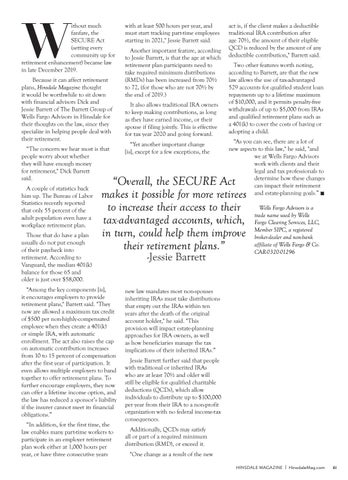W
ithout much fanfare, the SECURE Act (setting every community up for retirement enhancement) became law in late December 2019. Because it can affect retirement plans, Hinsdale Magazine thought it would be worthwhile to sit down with financial advisors Dick and Jessie Barrett of The Barrett Group of Wells Fargo Advisors in Hinsdale for their thoughts on the law, since they specialize in helping people deal with their retirement. “The concern we hear most is that people worry about whether they will have enough money for retirement," Dick Barrett said. A couple of statistics back him up. The Bureau of Labor Statistics recently reported that only 55 percent of the adult population even have a workplace retirement plan. Those that do have a plan usually do not put enough of their paycheck into retirement. According to Vanguard, the median 401(k) balance for those 65 and older is just over $58,000.
with at least 500 hours per year, and must start tracking part-time employees starting in 2021," Jessie Barrett said. Another important feature, according to Jessie Barrett, is that the age at which retirement plan participants need to take required minimum distributions (RMDs) has been increased from 70½ to 72, (for those who are not 70½ by the end of 2019.) It also allows traditional IRA owners to keep making contributions, as long as they have earned income, or their spouse if filing jointly. This is effective for tax year 2020 and going forward. “Yet another important change [is], except for a few exceptions, the
act is, if the client makes a deductible traditional IRA contribution after age 70½, the amount of their eligible QCD is reduced by the amount of any deductible contribution," Barrett said. Two other features worth noting, according to Barrett, are that the new law allows the use of tax-advantaged 529 accounts for qualified student loan repayments up to a lifetime maximum of $10,000, and it permits penalty-free withdrawals of up to $5,000 from IRAs and qualified retirement plans such as a 401(k) to cover the costs of having or adopting a child. “As you can see, there are a lot of new aspects to this law," he said, "and we at Wells Fargo Advisors work with clients and their legal and tax professionals to determine how these changes can impact their retirement and estate-planning goals.” ■
“Overall, the SECURE Act makes it possible for more retirees to increase their access to their tax-advantaged accounts, which, in turn, could help them improve their retirement plans.”
“Among the key components [is], it encourages employers to provide retirement plans," Barrett said. "They now are allowed a maximum tax credit of $500 per non-highly-compensated employee when they create a 401(k) or simple IRA, with automatic enrollment. The act also raises the cap on automatic contribution increases from 10 to 15 percent of compensation after the first year of participation. It even allows multiple employers to band together to offer retirement plans. To further encourage employers, they now can offer a lifetime income option, and the law has reduced a sponsor’s liability if the insurer cannot meet its financial obligations.” “In addition, for the first time, the law enables many part-time workers to participate in an employer retirement plan work either at 1,000 hours per year, or have three consecutive years
-Jessie Barrett
Wells Fargo Advisors is a trade name used by Wells Fargo Clearing Services, LLC, Member SIPC, a registered broker-dealer and non-bank affiliate of Wells Fargo & Co. CAR-0320-01296
new law mandates most non-spouses inheriting IRAs must take distributions that empty out the IRAs within ten years after the death of the original account holder," he said. "This provision will impact estate-planning approaches for IRA owners, as well as how beneficiaries manage the tax implications of their inherited IRAs.” Jessie Barrett further said that people with traditional or inherited IRAs who are at least 70½ and older will still be eligible for qualified charitable deductions (QCDs), which allow individuals to distribute up to $100,000 per year from their IRA to a non-profit organization with no federal income-tax consequences. Additionally, QCDs may satisfy all or part of a required minimum distribution (RMD), or exceed it. "One change as a result of the new HINSDALE MAGAZINE | HinsdaleMag.com
61










